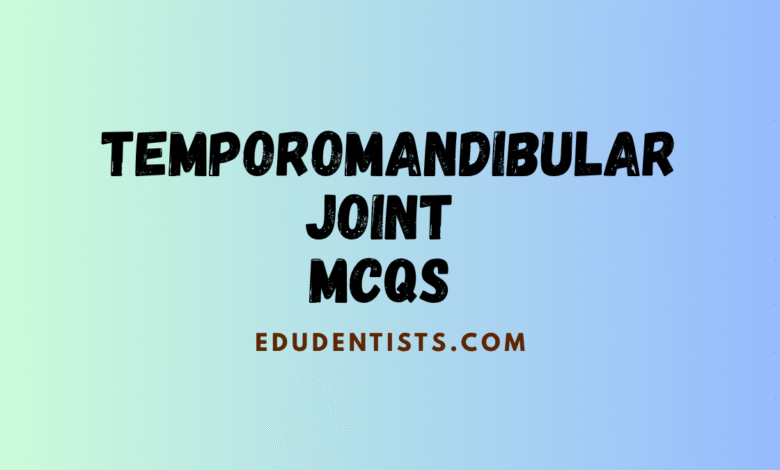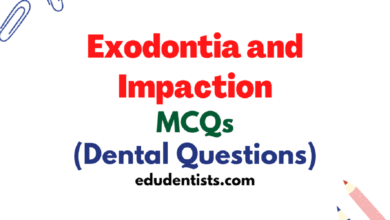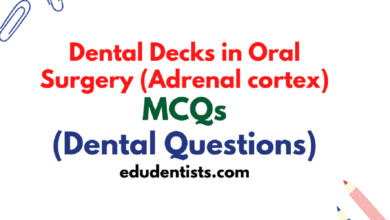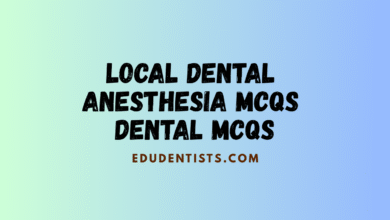Oral and Maxillofacial Surgery MCQs
Temporomandibular joint MCQs _ TMJ MCQs
Temporomandibular joint MCQs _ TMJ MCQs

Temporomandibular joint MCQs _ TMJ MCQs
Temporomandibular joint MCQs _ TMJ MCQs
- The commonest cause of TMJ ankylosis:
A. Trauma
B. Infection
C. Development disturbances
D. Atrophy - In which of the following the Condylar hypoplasia is seen in:
A. Down’s syndrome
B. Goldenhar’s syndrome
C. Grinspan syndrome
D. Crouzen disease - 8-year-old child fell on his chin and suffered trauma. When he opens his mouth, it deviates towards left, what is the possible condition?
A. Unilateral left TMJ ankylosis
B. Unilateral right TMJ ankylosis
C. Bilateral ankylosis
D. None - Extra articular ankylosis occurs due to:
A. Condyle
B. Coronoid process
C. Fibrosis
D. None of the above - Which of the following can caused by Hypertrophy of the mandibular condyle:
A. An anterior cross bite
B. Ipsilateral posterior open bite
C. Unilateral class III malocclusion
D. All of the above - Which surgical procedure is carried out to treat TMJ ankylosis?
A. Discoplasty
B. Arthroplasty
C. Condylectomy
D. Capsulorrhaphy - Early movement of TMJ following surgery for TMJ ankylosis is:
A. Desirable
B. Contraindicated
C. Harmful
D. B & C - In dislocation of the jaw, displacement of the articular disc beyond the articular tubercle of the temporomandibular joint results from spasm or excessive contraction of the following muscle?
A. Buccinator
B. Lateral pterygold
C. Masseter
D. Temporalis - Treatment of acute dislocation of TMJ is:
A. General Anaesthetia
B. Muscle relaxants
C. Mechanical manipulation
D. All of the above - The Risdon approach to the TMJ is a through:
A. Hemicoronal approach
B. Retroauricular approach
C. Preauricular approach
D. Submandibular approach - Commonest complication with Risdon and submandibular incision is:
A. Damage to marginal mandibular nerve
B. Damage to cervical branch of facial nerve
C. Damage to inferior alveolar nerve
D. Damage to lingual nerve - Unilateral TMJ ankylosis is associated with the following features, except:
A. Multiple carious teeth
B. Facial asymmetry with fullness on the normal side of mandible
C. Chin deviated towards the affected side
D. Prominent antegonial notch on the affected side. - Bird face appearance Is seen:
A. Unilateral TMJ ankylosis
B. Bilateral TMJ ankylosis
C. TMJ dislocation
D. Bilateral condylar fracture - Etiopathology of ankylosis of TMJ includes:
A. Intracapsular condylar fractures
B. Extracapsular condylar fractures
C. Both the above
D. None of the above - The tear of intracapsular articular disc of TMJ causes:
A. Dislocation
B. Ankylosis
C. Chronic pain
D. Arthritis - In a patient with 8-year-old having TMJ ankylosis, the treatment of choice is:
A. Gap arthroplasty
B. Treatment not required
C. Condylectomy
D. Gap arthroplasty with costochondral grafting - A 9 yr old child had trauma to TMJ and ankylosis. He had undergone arthroplasty. Which of the following graft is best suited to fill the gap?
A. Allograft
B. Xenograft
C. Costochondral graft
D. Alloplastic - TMJ dislocation most commonly occurs in which direction:
A. Anteriorly
B. Posteriorly
C. Medially
D. Laterally - TMJ Dislocation is treated by forcing the mandible:
A. Upwards and backward
B. Upwards and forwards
C. Downwards and forwards
D. Downward and backward - Emineetomy is done for treatment of:
A. TMJ ankylosis
B. TMJ dislocation
C. Coronoid fracture
D. All of the above - Submandibular incisions are preferred in extraoral ramus osteotomies mainly for:
A. Esthetics
B. Accessibility
C. Protection of vital organs
D. Rapid healing - Which of the following surgical approach is advocated for demonstrating the upper parts of and its meniscus?
A. Submandibular approach
B. Retromandibular approach
C. Preauricular and auricular approach
D. Oral approach - Of the following which is not a structural element of the TMJ?
A. Joint cavities
B. Condyloid process
C. Sigmoid notch
D. Articular disc - Pediatric patient planned for costochondral graft for TMJ ankylosis is intubated best by:
A. Topical anesthesia plus sedation
B. Awake fiberoptic intubation
C. Tracheostomy
D. General anesthesia - Which one is disadvantage of Costochondral graft
A. No growth
B. Overgrowth
C. Very less growth
D. Delayed growth - Which of the following is not done in treatment of ankylosis?
A. High condylar shave.
B. Ipsilateral coronoidectomy.
C. Contralateral coronoidectomy
D. Repositioning of temporal facia - In arthroscopy, for TMJ adhesion lysis, the LASER used is:
A. Argon
B. Er-Yag
C. He-Ne
D. Ho-Yag - Obstructive sleep apnea caused by the following:
A. Dentigerous cyst.
B. Bilateral TMJ ankylosis.
C. Orbital fracture.
D. Mandibular ameloblastoma - Most common cause of clicking:
A. Disc displacement with reduction
B. Disc displacement without reduction
C. Hypermobility
D. Loose articular bodies - TMJ is a:
A. Fibrous joint
B. Hinge joint
C. Ball and socket
D. Diarthrodial and ginglymoid joint - Initial clicking of TMJ while opening is due to:
A. Lateral displacement of the condyle.
B. Retruded condyle in respect to articular disc
C. Protruded condyle in respect to articular disc
D. Perforated disc - Dautry procedure is used for:
A. Correction of prognathism
B. Correct of ankylosis
C. Correcting recurrent dislocation of mandible
D. None of the above - The joint which histologically and morphologically best simulate the TMJ is:
A. Sternoclavicular graft.
B. 3rd metatarsal graft.
C. 5th costochondral graft
D. None of the above - Hydrocortisone acetate is injected in a painful arthritic TMJ to:
A. Decrease the inflammatory response.
B. Lubricate the synovial joint
C. Anesthetize the nerve supply
D. Increase the blood supply - When a patient’s chin and mandible deviate to the right upon opening, which of the following is a possible cause?
A. Ankylosis of the left condyle
B. Fracture of the left condyle
C. Hypoplasia of the right condyle
D. Hyperplasia of the right condyle - The most frequent direction in which the articular disc gets displaced is:
A. Posterior and medial direction.
B. Posterior and lateral direction
C. Anterior and medial direction.
D. Anterior and lateral direction - The joint cavity can be examined in detail without much surgical exposure by:
A. Sialography
B. Arthroscopy
C. Biopsy
D. Endoscopy - The Alkayat and Bramely approach to the TMJ is a modification of:
A. Hemicoronal approach
B. Retroauricular approach
C. Preauricular approach
D. Submandibular approach - Which cause bony fusion of the condylar head to the glenoid fossa:
A. Trauma
B. Atrophy
C. Development disturbances
D. Microorganisms - TMJ frequent dislocation is caused due to:
A. Spasm of masseter
B. Bony ankylosis
C. The articular eminence being smaller
D. All of the above - In TMJ the double contrast arthroscopy is used for:
A. Clicking of TMJ
B. Joint space
C. Deviation of TMJ
D. Disc - All are features of TMJ dislocation except
A. Anterior displacement of condyles
B. Deafness
C. Anterior open bite.
D. Can be reduced by applying pressure on the mandible in downward and backward direction - Trismus is due to the inflammation of
A. Buccinator
B. Facial nerve irritation
C. Superior constrictor
D. Medial pterygoid - Nerve that may be injured in submandibular incision:
A. Marginal mandibular branch of the facial nerve
B. Lingual nerve
C. Hypoglossal nerve
D. Mylohyoid nerve - In dislocation of the jaw, displacement of the articular disc beyond the articular tubercle of the temporomandibular joint results from spasm or excessive contraction of which of the following muscle?
A. Buccinator
B. Lateral pterygoid
C. Masseter
D. Temporalis - WHICH OF THE FOLLOWING IS CORRECT?
A. Roof of mandible contains thin, compact bone
B. Articular tubercle is composed of spongy bone covered with thin compact bone
C. Condyle contains red bone marrow
D. All of the above - The components of future TMJ shows development at_____________?
A. 6 weeks
B. 18 weeks
C. 10 weeks
D. 16 weeks - Which of the following is not included in muscles of mastication group:
A. Temporalis
B. Masseter
C. Lateral pterygoid
D. Mylohyoid - Swallowing cycle occurs _______ number of times during 24 hours:
A. 590
B. 860
C. 950
D. 490 - Which of the following is not and inflammatory joint disorder of temporomandibular joint:
A. Synovitis
B. Capsulitis
C. Osteomyelitis
D. Retrodiscitis - Normal range of mouth opening when measured interincisally is between:
A. 62 – 70 mm
B. 53 – 58 mm
C. 42 – 50mm
D. 20 – 32 mm - Which is true about the temporomandibular joint (TMJ?
I. Ginglymoarthrodial joint
II. Synovial joint
III. Allows for translational (gliding) movement
IV. The Posterior TMJ dislocations are more common than anterior dislocations
A. I, II, and III
B. II and IV
C. IV only
D. All the above - A patient having extremely inflamed retrodiscal tissue as a result of functional loading of an internally deranged TMJ. What is the next course of action after all conservative treatment has failed to resolve the problem?
A. Arthrocentesis
B. Arthroscopic surgery
C. Prosthetic restoration
D. Occlusal adjustment
E. Orthognathic surgery - A patient presents with pain localized to the right preauricular region and trismus. During clinical examination, he has limited range in jaw movements and a right posterior open bite. CT maxillofacial shows a calcified growth of his right condyle, which you suspect to be an osteochondroma. You plan to resect the right condyle and condylar neck. which muscle would be required to be stripped, according to your plan, to remove the condylar segment successfully?
A. Temporalis
B. Masseter
C. Lateral pterygoid
D. Medial pterygoid - Which is a type of TMJ joint ?
A. Ginglimus
B. Diarthroidial
C. Capable of hinge and gliding movement
D. All of the above - Articular surface of TMJ consist of ?
A. Concave articular glenoid fossa
B. Convex articular tubercle
C. Both A and B
D. None of the above - The TMJ articulating surfaces covered by ?
A. Lateral ligament
B. Retrodiscal lamina
C. Fibrocartilage
D. Loose connective tissue - All true about the articular disc, except:
A. Biconcave
B. Fibrous
C. Thinner in its central portion than periphery
D. Thinner at the periphery than central portion - Articular disc divides joint into ?
A. Superior and inferior compartments
B. Anterior and posterior compartments
C. Postero, intermediate and anterior
D. None of the above - The disc is attached posteriorly and anteriorly respectively to ?
A. Tendon of lateral pterygoid and retrodiscal pad
B. Retrodiscal pad and tendon of lateral pterygoid
C. Sphenomandibular ligament and tendon of lat. Pterygoid
D. Tendon of lat. pterygoid and sphenomandibular ligament - The volume of upper joint space is:
A. 2.1 ml
B. 1.9 ml
C. 0.9 ml
D. 1.2 ml - Which of the following consider as accessory ligaments of TMJ:
A. Spenomandibular and Stylomandibular
B. Stylomandibular and stylohyoid
C. Sphenomandibular and stylohyoid
D. Stylohyoid and mylohyoid - The Blood supply of TMJ is from:
A. Deep temporal artery
B. Maxillary artery
C. Superficial temporal artery
D. Facial artery - The Frequent dislocation of the temporomandibular joint is due to:
A. Spasm of muscles of mastication
B. Articular eminence being smaller
C. Decreased free way space
D. All of the above - Trismus is due to:
A. Facial pterygoid inflammation
B. Facial nerve irritation
C. Superior constrictor inflammation
D. Buccinator inflammation - Condyle repeated dislocation can be treated by intentional fracture of Zygomatic arch and reunion, this procedure called:
A. Stobes method
B. Dautery procedure
C. Denkel’s method
D. Weber’s procedure - Common least cause of TMJ ankylosis is:
A. Trauma
B. Developmental disturbances
C. Infections
D. Atrophy - TMJ ankylosis treated by which surgical procedure?
A. Arthroplast
B. Condylectom
C. Discoplasty
D. Capsuloraphy - TMJ ankylosis treatment:
A. Capsulorrhaphy
B. Physiotherapy
C. Condylectomy
D. None of the above - Connectomy is carried out for treatment of:
A. TMJ ankylosis
B. TMJ dislocation
C. Coconsid treatment
D. All of these - Capsulorrhaphy is:
A. Form of capsule tightening procedure
B. Form of creating a mechanical obstacle
C. Form of direct restraint of condyle
D. Form of creation of new minds balance - Which of the following is Not a clinical manifestation of unilateral ankylosis:
A. Receded chin
B. Bird face appearance
C. Deviation of mandible on affected side
D. Cross test - The Frey’s syndrome associated with:
A. Auriculotemporal nerve
B. Facial nerve
C. Temporal nerve
D. Superior alveolar nerve - TMJ ankylosis Recurrence due to which of the following:
A. Inadequate gap created
B. Fracture of costochondral graft
C. Inadequate coverage of glenoid fossa surface
D. All of the above - In the unilateral ankylosis, chin is on:
A. Affected side
B. Unaffected side
C. Equal on both sides
D. None of the above - Which clinical disease of the following affect directly the TMJ:
A. Ankylosis
B. Arthritis
C. Dislocation
D. All of the above - A woman has an opening click of TMJ. 6-months ago, she sustained blunt facial trauma in a motor vehicle accident. Of the following, which is the most likely cause of the opening click of TMJ?
A. Air in joint space
B. Bony foreign bodies in joint space
C. Contact of condylar head against articular eminence
D. Contact of mandibular condyle against glenoid fossa
E. Articular disk subluxation - Which of the following symptoms is the most suggests internal derangement of the TMJ in patients have sustained trauma to the mandible and TMJ?
A. Clicking
B. Decreased range of motion of the mandible
C. Deviation of the mandible with function
D. Pain
E. Tinnitus - A patient is unable to close the mandible after yawning. He recently underwent a bilateral mastectomy and immediate reconstruction with a bilateral transverse rectus abdominis myocutaneous flap through general anesthesia. At that time, he had a difficult intubation because of an anatomically short neck. Which is appropriate initial step of management?
A. Alloplastic replacement of the condylar head
B. Augmentation of the articular eminence
C. Gap arthroplasty using the temporalis muscle
D. Maxillomandibular fixation in centric occlusion
E. Reduction while the patient is sedated - 3 months after blunt trauma to mandible, a 40-year-old woman has pain in the TMJ, decreased range of mandibular motion, and the chin point deviated to affected side with chewing. The maximum vertical dimension of opening of 2 cm and CT scans show a non-displaced fracture of the intra-capsular condylar head.
Which is the most likely cause of the decreased range of motion of the mandible?
A. Adhesions of the temporalis muscle
B. Bony ankylosis of the TMJ
C. Degenerative joint disease
D. Fibrous ankylosis of the TMJ
E. Myofascial pain dysfunction - Which of the following conditions are predisposed to development of TMJ disorders?
A. Angle class I occlusion
B. Anterior tooth loss
C. Microgenia
D. Prognathism
E. Short-face syndrome - A patient has temporal headaches and “sand in the jaw” sensation when eats. There is transient locking of the jaw during opening and closing movements and reciprocal clicking. MRI shows anterior malpositioning of the meniscus and posterosuperior displacement of the condyle. With which of the following these findings are most consistent?
A. Ankylosis of the TMJ
B. Avascular necrosis of the condylar head of the mandible
C. Dislocation of the TMJ
D. Internal derangement of the TMJ
E. Myofascial pain dysfunction syndrome - Which of the following are Not considered as normal variations of TMJ function in a child:
A. Occlusal wear
B. TMJ pain with no clinical signs and symptoms
C. sounds of joint
D. Limitation of mouth opening - Articular disc of TMJ best visualized through:
A. MRI
B. CT
C. Panoramic x-ray
D. Ultrasound - Deviation of the mandible to the left side on opening may be caused by:
A. Right TMJ disc anterior displacement without reduction
B. Left TMJ disc anterior displacement without reduction
C. Right TMJ effusion
D. Bony ankylosis - A 10 year old patient, following trauma to jaw as an infant, has a worsening facial asymmetry and now has extreme limitation of opening with no other joint problems in the body. The most likely diagnosis:
A. Fracture of condylar neck
B. Ankylosis
C. Juvenile chronic arthritis
D. Osteoarthrosis





